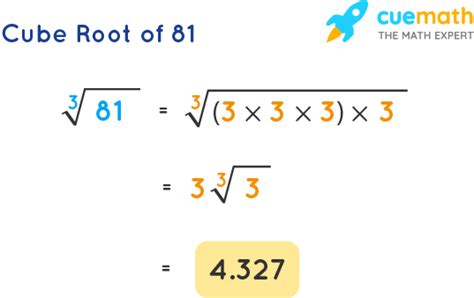What Is The Cubed Root Of 81
News Co
Apr 07, 2025 · 4 min read

Table of Contents
What is the Cubed Root of 81? A Deep Dive into Cube Roots and Approximations
The question, "What is the cubed root of 81?" seems simple at first glance. However, delving into its solution reveals a fascinating exploration of mathematical concepts, approximation techniques, and the nuances of irrational numbers. Unlike perfect cubes like 64 (4³) or 125 (5³), 81 doesn't have a neat, whole-number cube root. This necessitates a deeper understanding of how to approach such problems.
Understanding Cube Roots
Before tackling the cube root of 81, let's establish a firm understanding of what a cube root actually is. The cube root of a number, denoted as ³√x, is a value that, when multiplied by itself three times (cubed), equals x. In simpler terms:
(³√x) * (³√x) * (³√x) = x
For instance:
- ³√64 = 4 because 4 * 4 * 4 = 64
- ³√125 = 5 because 5 * 5 * 5 = 125
- ³√1 = 1 because 1 * 1 * 1 = 1
- ³√0 = 0 because 0 * 0 * 0 = 0
Why 81 is a Challenge
The cube root of 81 presents a challenge because 81 isn't a perfect cube. There's no whole number that, when cubed, results in 81. This means the cube root of 81 is an irrational number, meaning it cannot be expressed as a simple fraction and its decimal representation goes on forever without repeating.
Methods for Approximating ³√81
Since we can't find an exact value, we need to employ approximation techniques. Here are a few methods:
1. Using a Calculator
The most straightforward method is using a calculator with a cube root function (often denoted as ³√ or x^(1/3)). Simply input 81 and press the cube root button. The calculator will provide a decimal approximation, typically accurate to several decimal places. You'll find that:
³√81 ≈ 4.32674871...
This approximation is sufficient for most practical purposes.
2. The Newton-Raphson Method
For those interested in a more sophisticated approach, the Newton-Raphson method is an iterative numerical method used to find successively better approximations to the roots of a real-valued function. To apply this to finding the cube root of 81, we'd use the function f(x) = x³ - 81 and its derivative f'(x) = 3x². The iterative formula is:
x_(n+1) = x_n - f(x_n) / f'(x_n)
Starting with an initial guess (e.g., x_0 = 4), we can repeatedly apply this formula to obtain increasingly accurate approximations. While this method is powerful, it's computationally intensive without the aid of a computer program or spreadsheet.
3. Linear Interpolation
A simpler approximation method is linear interpolation. This involves finding two perfect cubes that bracket 81. We know that 4³ = 64 and 5³ = 125. Since 81 lies between 64 and 125, we can linearly interpolate:
- The difference between 125 and 64 is 61.
- The difference between 81 and 64 is 17.
- The proportion is 17/61.
Therefore, an approximate cube root can be calculated as:
4 + (17/61) * (5-4) ≈ 4.2787
This method provides a reasonable approximation, although less accurate than the calculator or Newton-Raphson method.
Understanding the Irrational Nature of ³√81
The fact that ³√81 is irrational is crucial. Irrational numbers, by definition, have decimal representations that neither terminate nor repeat. This means any decimal approximation is just that – an approximation. The true value of ³√81 possesses infinite non-repeating digits.
This highlights a fundamental aspect of mathematics: many numbers are not neatly expressible as simple fractions or terminating decimals. The realm of irrational numbers is vast, and the cube root of 81 is just one example of its complexity.
Applications and Relevance
While the cube root of 81 might seem like an abstract mathematical exercise, it has practical applications in various fields:
- Geometry: Calculating volumes of cubes or other three-dimensional shapes might involve finding cube roots.
- Engineering: Many engineering calculations, particularly those involving cubic relationships, require working with cube roots.
- Physics: Certain physical phenomena, like the relationship between volume and pressure in gases, may involve cube root calculations.
- Computer Graphics: Cube roots are used in computer graphics algorithms for transformations and rendering.
Conclusion: Beyond the Calculation
This exploration goes beyond simply finding the numerical value of ³√81. It demonstrates the importance of understanding different approximation methods, the nature of irrational numbers, and the relevance of these mathematical concepts in real-world applications. The seemingly simple question about the cube root of 81 opens up a window into a rich world of mathematical concepts and their practical significance. Whether you use a calculator for a quick approximation or delve into more sophisticated methods, the understanding gained through this investigation is invaluable. The pursuit of knowledge, even in a seemingly basic mathematical problem, reveals the beauty and complexity hidden within seemingly simple numbers. Remember, mathematics isn't just about numbers; it's about the relationships, patterns, and methods we use to understand them.
Latest Posts
Related Post
Thank you for visiting our website which covers about What Is The Cubed Root Of 81 . We hope the information provided has been useful to you. Feel free to contact us if you have any questions or need further assistance. See you next time and don't miss to bookmark.